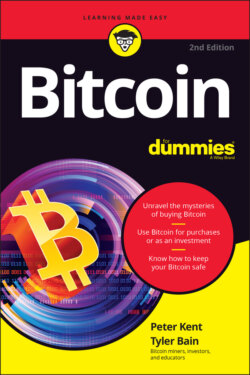Читать книгу Bitcoin For Dummies - Peter Kent - Страница 20
Milton Friedman and the rai stones
ОглавлениеEminent, Nobel Prize–winning economist Milton Friedman wrote a paper in the 1990s about rai stones — a form of money once used on the Yap islands — comparing this system to the use of gold by Western nations to back their currencies.
The Yap islands are a group of four small islands in the middle of the Pacific Ocean, about 800 miles east of the Philippines. With a population of around 12,000, Yap isn’t known for much, except perhaps, most notably, for an unusual form of money it used to have, known as rai (or fei) stones.
Rai stones were “coins” made of limestone. You couldn’t carry these coins around in your pockets because they were large, sometimes very large. The stones had holes in the middle for a log to be threaded through so they could be carried! (If you’d like to see what we’re talking about, do a quick image search online for rai stones.)
They mostly weren’t carried, though; in fact, they sat where they were long enough to gather moss. Anyway, here’s how these things worked. Let’s say you wanted to buy a bunch of coconut copra (the dried kernels from which coconut oil is extracted, which is big business in the Yap islands). You would go to the seller and say something like, “You know my rai stone in the woods by the river? Well, I’ll give you the rai stone in exchange for the copra.” Assuming the price was right, you and the other party would then tell everybody that you no longer owned that particular rai stone, that it was now in the possession of the seller.
Note, by the way, that there was a degree of rarity to these stones. You couldn’t simply grab a piece of limestone and make your own money. Apart from the amount of work required to create one of these things, there was an additional problem: There isn’t any limestone on the Yap islands! Instead, limestone has to be quarried in Palau and brought back, a round trip of about 600 miles. (This is known in currency circles as proof of work, something you can learn more about in Chapter 7.)
There’s even a famous story (well, famous for people who know about rai stones!) about a large rai stone falling overboard during a journey back from Palau. One can imagine the conversation.
Sailor 1: “Oh, no, we’ve lost that huge stone, that was valuable!”
Sailor 2: “Oh, boy, we’re going to be in trouble! Oh, but wait, we know more or less where it is, right?”
And thus, that particular rai stone remained in circulation as long as the owner could say, “You know that rai stone I own, the one that sunk?”
Now, back to Milton Friedman. In his paper about this form of currency, he discussed what happened when the islands were occupied by Germany. (Rai stones were in use right up until the early 20th century.) The German authorities, he writes, were unable — not surprisingly — to get the local population to provide labor (to improve roads and paths on the islands, for instance).
But the German administrators had an idea. They sent someone out to paint black crosses on the rai stones, telling the locals this meant that they — the Germans — now owned them! They were, in effect, fining the local population for not providing labor.
This actually worked, which shows that the Yapese — perhaps like some readers of this book — didn’t really understand what money was (a belief) and how it functioned (carried value only as long as people believed in that value). The local population provided labor to get their money back (the crosses were erased).
Now, Friedman took the story further. He discussed an event that occurred in 1932, far from the Yap islands. France asked the Federal Reserve Bank of New York to convert some of its dollar assets into gold. Rather than shipping gold to France, the bank employees simply went into its vaults and moved the gold around a little, putting the appropriate amount of gold bars into particular drawers, and marking those drawers to show they were owned by France. (This event actually led to a banking panic in the U.S., as newspapers decried the loss of gold to France.)
Friedman compared the marking of the rai stones with the marking of the gold; he explains that Federal Reserve officials set apart the amount of gold required and marked the gold to indicate that it belonged to France. As Friedman explains, “For all it matters, they could have done so by marking them ‘with a cross in black paint’ just as the Germans did to the stones.”
You can read this paper at https://miltonfriedman.hoover.org/internal/media/dispatcher/215061/full. It is actually helpful, a way to shake up your thinking about money and what it really is. Let’s just see how Friedman finished up his paper:
What both examples—and numerous additional ones that could be listed—illustrate is how important “myth,” unquestioned belief, is in monetary matters. Our own money, the money we have grown up with, the system under which it is controlled, these appear “real” and “rational” to us. The money of other countries often seems to us like paper or worthless metal, even when the purchasing power of individual units is high.
Money does not actually exist. It’s merely an idea. Yes, we have coins and bills that represent money, but they are not the actual money itself, and they have little or no intrinsic value. Without the belief in the underlying promise behind money, the physical representation has no value, as the people of Zimbabwe discovered in 2008.
